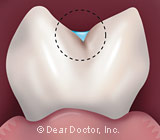 The eruption of your child’s first permanent teeth is a milestone in his or her development. As parents, you want to help your child preserve and protect their new permanent teeth so that they can last a lifetime. Dental sealants are one easy, simple, and inexpensive way to protect them from decay.
The eruption of your child’s first permanent teeth is a milestone in his or her development. As parents, you want to help your child preserve and protect their new permanent teeth so that they can last a lifetime. Dental sealants are one easy, simple, and inexpensive way to protect them from decay.
How do cavities develop?
The back teeth (premolars and molars) are formed with deep grooves on their biting surfaces that we call “pits and fissures.” These crevices are too deep for toothbrush bristles to reach. Bacteria can therefore grow and thrive inside them. The acid produced by these bacteria begins to dissolve the tooth enamel, starting the decay process.
Are new teeth more vulnerable?
Yes, the enamel surface of newly erupted teeth is more permeable and less resistant to tooth decay. As the enamel matures, it becomes more resistant.
How can you prevent decay in these new teeth?
Good oral hygiene habits, nutrition (including low sugar consumption), together with fluoride, sealants, and regular dental visits strengthen the teeth and can dramatically reduce tooth decay.
How does fluoride protect these teeth?
Fluoride makes the enamel surface harder and more impermeable and, therefore, less susceptible to acid attack and decay. Fluoride adds some protection to the deep pits and fissures of the teeth but they are still at high risk because of their shape and they often need further protection.
What are sealants and how do they work?
Sealants are protective coatings placed in the tiny pits and fissures to seal them from the bacteria and acids that promote decay. They actually “seal” the pits and fissures to prevent decay and can be used in the treatment of very early decay by arresting it. Greater use of sealants could reduce the need for subsequent treatment and prolong the time until treatment may become necessary.
Contact us today to schedule an appointment or to discuss your questions about dental sealants for your children. You can learn more about them by reading the Dear Doctor magazine article “Sealants for Children.”



